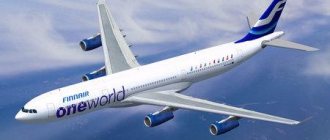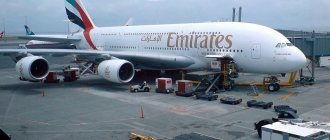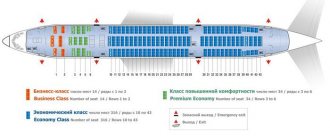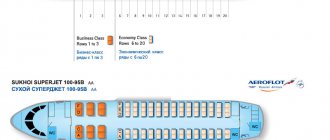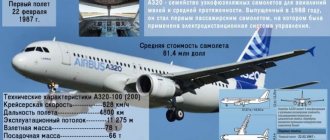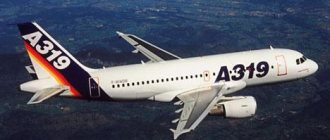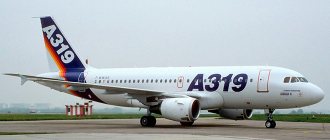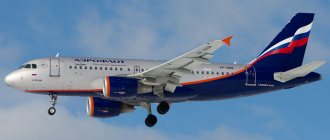Airbus A320 on takeoff. The plane is painted in the colors of China Southern Airlines. Most air travel takes place over distances of one to five thousand kilometers. That is why the largest production runs are not huge, amazing double-decker Airbuses, but much more modest medium-range aircraft. One such airliner is the Airbus A320. This winged aircraft appeared much later than its main competitors, however, it managed to significantly displace them, especially in the European air transportation market. Much of this success was due to the bold use of newly emerging technologies, the use of new, previously non-existent materials, and, of course, a competent marketing campaign.
History of the development of the Airbus A320 passenger aircraft
One of the main “aviation” events of the last quarter of the last century was the appearance of the twin-engine wide-body airliner A300. The Airbus concern, which created this aircraft, arose in 1970 as a result of the merger of aircraft manufacturing firms from several European countries. The “debut” of the new manufacturer looked promising, and allowed the company’s management to think about conquering the largest segment of the market – its “medium-haul” part.
The task was difficult. Firstly, a completely different aircraft was required, and not just a modification of the A300. Secondly, the positions of potential competitors looked unshakable. The main medium-haul airliners in those years were the Boeing 737 and McDonell Douglas DC9. To outperform these aircraft, it was necessary to use the most advanced and advanced technologies.
The McDonell Douglas DC9 was one of the A320's original rivals. In its aerodynamic design, this aircraft is reminiscent of some Soviet airliners
The concept of a fundamentally new airliner was created not only by Airbus. The British research center British Aerospace has done quite a lot of work in this direction. The Joint European Transport project developed there subsequently became a kind of base for all varieties of the A320. This designation itself was introduced in 1981. At the same time, the approximate parameters of the future airliner were determined: capacity - about 150 passengers, flight range - approximately 3.5 thousand kilometers.
It was necessary to get ahead of competitors in several main areas:
- It was necessary to install a fly-by-wire control system on the aircraft. This made it easier for the crew to work, while at the same time making the flight much safer;
- It was necessary to provide a higher level of comfort for passengers. To do this, the fuselage of the airliner had to become wider than that of the Boeing 737;
- It was necessary to significantly reduce specific fuel consumption and reduce the noise of the power plant. The plane was to be equipped with advanced engines.
Additional benefits were promised by the introduction of composite materials, thanks to which the overall weight of the aircraft was significantly reduced while maintaining structural strength and basic operational characteristics.
The first, “organizational” stage of creating the future A320, was greatly delayed due to contradictions among the management of the concern. Disputes arose over the issue of territorial distribution of production across different countries. It was possible to begin practical work only in 1984.
One of the first production Airbus A320s delivered to Germany. After 25 years of service, he died, presumably due to the intentional actions of the pilot.
The Airbus A320 made its first flight on February 22, 1987. This event became a real celebration, in which prominent European politicians took part. In 1988, after receiving the certificate, the first production aircraft were transferred to Air France.
In the following decades, several additional variants of the airliner were created, which received their own designations - A319, A321 and A318. The most modern modification of the aircraft is the A320neo. Its main difference is the new generation engines. Some changes have also been made to the aerodynamic design.
How many people are on a Boeing 737? How planes are refueled
| Airbus A320 Powerful air conditioners work to purify the air, and there are also individual directional lighting devices that are quite bright, but do not disturb others. For safety reasons, these seats are prohibited from being occupied by minor travelers, disabled people, the elderly, passengers with small children and animals, as well as pregnant women. |
- An-2 (“maize plant”) – 131 kg per hour;
- Tu-154M – 5300 kg per hour;
- IL-86 – 10400 kg per hour;
- Boeing 747-300 – 11300 kg per hour;
- Tu-144S – 39,000 kg per hour.
Performance characteristics (design features)
At first glance, the Airbus A320 may seem very similar to its main “rival” - the American Boeing 737. A vertical fin, a swept wing with two engines located under it, a “lower” version of the elevator layout - all this is typical for many other modern aircraft . We are, of course, not talking about plagiarism or copying; it’s just that over the years of development of civil aviation, the designers managed to come to the most optimal design.
Pilots control the flight of the A320 using so-called sidesticks - side sticks. The once familiar steering wheels are missing from the cockpit. Both vertical and horizontal rudders, as well as wing mechanization elements, are driven by hydraulics; there are no manual drives. The entire control system is as computerized as possible. Thanks to this, two pilots are enough for full piloting and navigation.
A Boeing 737 (above) and an A320 belonging to the same airline. External differences - sloping landing gear on the A320, overhang in front of the fin on Boeing
The tactical and technical characteristics of the airliner are as follows:
| Length | 37.57 meters |
| Height | 11.8 meters |
| Wingspan | 34.1 meters |
| Commercial load weight (maximum permissible) | 17.9 tons |
| Fuel volume in tanks | Up to 29,840 liters |
| Empty weight | 40.3 tons |
| Takeoff weight | From 64 to 75.5 tons |
| Landing weight | From 61 to 62.5 tons |
| Number of passengers | 150 (standard layout), 180 (without business class) |
To ensure quick evacuation in the event of dangerous situations, there are four emergency exits in the aircraft cabin.
Video
For the Boeing 737-800, the most popular is the two-class cabin layout.
On this version of the aircraft, the first five rows are considered business class seats with a distance between seats of 1 meter. There are 4 seats in one row in business class. Thus, there are 4 people in comfortable seats in Boeing business class. From rows 6 to 28 there are economy class seats. The difference is that the distance between the seats is much smaller and 6 people sit in one row. A Boeing 747 consumes an average of 12 thousand liters of aviation fuel per hour, the smaller 737 consumes about 3 thousand liters per hour. An Airbus A320 consumes an average of 2.7 thousand liters of kerosene per hour. TU-154 “eats” about 6 thousand liters per hour.
How much does it cost to refuel a plane? Filling a full tank of an Airbus aircraft will cost 960,000 rubles.
To refuel the aircraft, 90,770 liters of fuel are required. This amount of fuel is enough to fuel 1,200 minivans. The time to fully refuel the aircraft is 28 minutes.
THIS IS INTERESTING: Question: Is it possible to ride a Pitbike through fields and forests?
Flight data
The performance characteristics of the A320 can be summarized in a simple table:
| Maximum speed | 890 km/h |
| Cruising speed | 840 km/h |
| Flight range (under load) | Up to 6100 km |
| Service ceiling | 11,900 m |
| Takeoff run length | 2,090 m |
| Landing distance | 1,530 m |
During its flight, the airliner consumes 2,600 kilograms of fuel per hour (with the cabin fully loaded). That is, in order to transport one passenger over a distance of one kilometer, this plane consumes only 19.1 grams of kerosene.
Advantages and disadvantages
As of the end of June 2022, the total number of Airbus A320 aircraft built reached 8,977.
Qatar Airways Airbus A320
Such an impressive “circulation” testifies to the enormous popularity of this aircraft, due to its following advantages:
- Engine efficiency, low fuel consumption;
- Convenient controls that facilitate the work of the crew;
- Low noise level both during takeoff and landing and at altitude;
- Stability when exposed to upward or downward air currents.
Like any other complex aircraft, the A320 aircraft is not without certain disadvantages. In particular, not all passengers are delighted with the conditions in the cabin. A number of reviews express complaints related to cramped conditions.
Some aviation experts believe that the aircraft's total lifting surface area is too small for its weight, making it difficult to control at low altitudes and at low flight speeds. In addition, there are certain difficulties when making changes to the software.
How many kilometers per hour does a Boeing 737 fly? What do you season with corn?
| AIRBUS A320, A321. Interior layout. Best places in 2022 Fuselage, caisson wing, empennage, cockpit, control system, landing gear, hydraulic system, power plant, fuel system, oxygen equipment, air conditioning system. Space exploration means solving problems such as the history of the Earth and the origin of life, weather forecasting, mineral exploration, television, long-distance communications and much more. |
| Quick answer: How much fuel does a plane consume per 100 km? Online auto repair shop Manufacturers create cars that are so similar in characteristics that the main difference that influences customer choice is external characteristics and brand loyalty. Next, we will consider which aircraft is better than the Boeing 737 or Airbus A320 based on a comparison of the main characteristics, capacity, cost and comfort of the aircraft. |
In-flight entertainment system, power outlets, wifi • Work is currently underway on the A321 NEO.
Airbus A320 interior diagram
Seats in the economy class of the Airbus A320 (Finnair company)
The main part of the internal space of the airliner is occupied by passenger seats. They come in two types - economy class and business class. The main entrances to the cabin are located at the head and tail of the aircraft. In front, behind the cockpit, on the left side relative to the central aisle, there is a toilet. Opposite it is a small “kitchen” room. Two more toilets are located in the rear of the cabin, on either side of the aisle.
Business Class
Up to twelve passengers on the A320 can travel in enhanced comfort. The Business Class seats provided for this purpose are located at the front of the cabin. The seats, 57 centimeters wide, are arranged in three rows in a 2x2 pattern. The central aisle is slightly wider than in economy class, and there is more free space for each passenger. The spacing between rows of seats is 90 centimeters. Business class ends with a partition separating it from the rest of the cabin.
Economy class
Most of the A320 cabin is occupied by passenger seats up to 45.7 centimeters wide, installed in a 3x3 configuration. The interval between rows is 80 centimeters. This part of the aircraft can accommodate up to 150 people. The width of the central aisle is 63.5 cm. In most cases, this is enough for people to move freely around the cabin without disturbing those sitting in seats C and D.
You can use touch screens to call a flight attendant or communicate with the aircraft crew. They are built into the backs of the seats, so passengers sitting in the very first row have to do without them. Each row is also equipped with LED lights that complement the common ceiling lamps.
General view of economy class on the A320. Touch displays on the backs of the seats are clearly visible
Worst places
When purchasing tickets for an Airbus A320, the cabin layout will help you choose the most comfortable seats for each passenger.
Typically, people try to avoid the last row of passenger seats. Firstly, there are toilets very close by, creating noise and sometimes an unpleasant odor. Secondly, the backs of the seats cannot be reclined - they rest against the partition. The penultimate row is devoid of this drawback, however, the proximity of the toilet is felt here too.
Passengers also do not like the location of the first row of seats in economy class. Many people do not like to admire the partition throughout the flight, while others experience discomfort due to the lack of a touch screen.
Diagram of the standard Airbus A320 cabin layout
Inconvenience also arises for those passengers who end up in seats located near emergency exits. This is usually due to the limited functionality of the back of the chair. Sometimes drafts arise in this part of the cabin, which is also unpleasant.
Similar documents
In addition, the classic aircraft steering wheels are replaced with special side-stick handles located on the sides of the cockpit, so the sidestick of the pilot sitting on the left is usually the aircraft commander located to the left of his seat, and the sidestick of the pilot sitting on the right is usually the co-pilot is located on the right from his seat. Mainly used are Glass-fiber reinforced plastic, Carbon-fiber reinforced plastic, honeycomb core honeycomb core.
Aircraft safety
It should be noted that in the first years of operation of the airliner, the main problem of the A320 was the accident rate. One of the first production airliners crashed during a demonstration flight. After this, in 1990 and 1992, two major disasters occurred with a large number of victims. These events significantly undermined the airliner's reputation and caused distrust in its computerized control system.
In total, to date, 1,393 people have died as a result of accidents on the A320 aircraft (taking into account all its modifications). The worst tragedy was the death of 224 people flying on the A321 airliner from Egypt to Russia on October 31, 2015. True, in this case there can be no claims against the plane, since we are talking about a terrorist attack. However, the circumstances of a number of other disasters suggest that the airliner's control system was not flawless. An example is the incident that occurred on December 28, 2014, when, as a result of an on-board computer failure, an A320 crashed into the Java Sea, killing 162 people.
The site of the crash of an Airbus A320 plane that crashed into the mountains in southern France
In general, out of almost nine thousand aircraft produced at different times, 42 units were lost for various reasons. In ten cases, the crash of the airliner resulted in significant casualties.
Airbus A320 modifications
It was initially assumed that the aircraft would be built in two main versions. They were previously designated Airbus A320 200 and A320 100. These modifications were to differ both in cabin capacity and overall length. These plans were then revised and only the Airbus 320 200 was actually built.
Subsequently, several modifications of the basic model were developed:
- A319 is a shortened version of the airliner. The number of passengers has been reduced and can range from 116 to 156 people. Additionally, several submodifications of this aircraft were built, including the Airbus A319ACJ, designed to transport VIP passengers;
- A321 is the largest variant. The number of passenger seats has been increased to 220 due to some lengthening of the fuselage;
- The A318 is an airliner designed for short runways. It can carry up to 132 passengers, and in the standard configuration - 107. There is an Elite submodification - a “corporate aircraft”.
In recent years, a transition has been made to the production of the entire model range in the neo version, with improved engines and improved electronic equipment.
The Airbus A318 airliner is one of the modifications of the basic A320-200
Manufacturer
The Airbus A320 is produced by the Airbus SAS aircraft manufacturing group, its headquarters is located in Toulouse, France, and the aircraft itself is assembled in factories in three countries: France, Germany (Hamburg) and Britain.
Airbus SAS headquarters in Toulouse
Since 2011, another assembly line has been launched in China. Airbus Corporation's workforce exceeds 50 thousand people. The very name of the airliner, “Airbus,” translates as “air bus”; it was the only acceptable linguistic option for the French management of the company.

